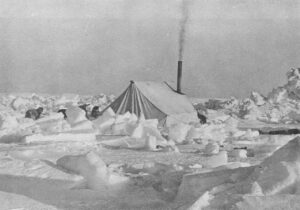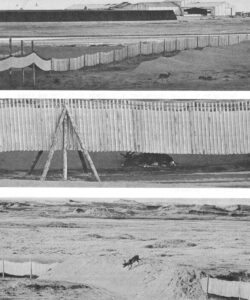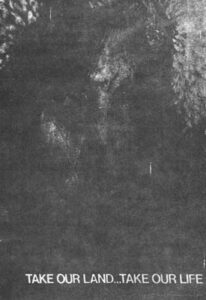Lael Morgan
- 1972

Fellowship Title:
- Alaskan Eskimos, Aleuts and Indians in Transition
Fellowship Year:
- 1972

Point Hope – A Workable Tradition?
Point Hope, Alaska May 16, 1972 The Eskimo word for “whale”is a harsh whisper on the restless ice of the Chukchi Sea off Point Hope. A light whale boat, umiak, fashioned from sealskin covered driftwood, slips into the gray water of a fog-shrouded lead. Six men, moving as one, paddle soundlessly, cross-current; evading the sweep of jagged, fast-moving ice blocks. AGVIK…! Suddenly, squarely in their course, a bowhead surfaces. Its black hulk is three times the length of the boat but the Eskimos move without hesitation to attack with a hand thrust of an ancient harpoon fixed to a black powder charge. They strike but the mammoth takes only a glancing blow, sounds and surfaces well beyond range. The lead narrows. South wind pushes forward a crushing front of ice and the men retreat before it, dragging their umiak on a flat wooden sled. We women of the crew watch from older, more stable ice. We have packed the food and cooking pots and are ready to break camp as we have many times. Packing,

The Last of the Independents?
Anchorage, Alaska March 24, 1972 The people of Anaktuvuk Pass were the last of Alaska’s independent Eskimos. For centuries they followed the track of the migratory caribou through the Brooks Range far north of the Arctic Circle. They were proud to call themselves “Inupiat” -The Real People. They lived wholly by hunting; subsisted in the earth’s fiercest cold in tents of caribou skins and splendid fur clothing designed by their forefathers. At the end of the century whale hunters killed off the game, forcing the Eskimos to abandon the mountains and camp with coastal cousins. There they discovered the white man and the civilization he was introducing, but the Anaktuvuk people remained aloof. When the caribou herds grew strong enough in the late 30s, a small nucleus of families moved back into the mountains and more joined them as the game increased. Long after other Eskimos had settled into the white man’s ways, the Anaktuvuk people enjoyed a free, nomadic life. To the east their Canadian counterparts grew dependent on the traders, dulled their

Caribou Versus Pipeline: Can They Take it in Stride?
Anchorage, Alaska March 19, 1972 The Pipeline Will Do For The Caribou What The Railroad Did For The Buffalo! That’s the theme of a current conservationist poster and, if the proposed trans-Alaskan oil pipeline does block caribou migration, it bodes a cold and hungry future for several thousand Alaskan natives. Over 20 Eskimo and Indian villages in the neighborhood of the pipeline depend on caribou for food and clothing. Some use the meat only to supplement their diets but tradition-bound villages like Anaktuvuk Pass, live almost exclusively on caribou. The average Anaktuvuk family consumes one caribou a week or one every five days if a dog team must be maintained. Almost all winter footwear is made of caribou skin and hunters need a heavy caribou fur atigi (parka) to survive. The Anaktuvuk people also use caribou skins for their small but growing mask-making industry. Nothing Wasted – Natives who hunt caribou for subsistence usually utilize the animal to the fullest. Even the small bits of meat near the hoof will be eaten. The fur

The Alicia Patterson Fund Sub-Polar Expedition
January 31, 1972 Preparations for the Alicia Patterson Fund Sub-Polar Expedition (APFSE) have been long, laborious and a trifle unnerving. At destination Anaktuvuk Pass the chill factor ranges from -20º to -80º which could be the makings of a fast-frozen “fellow.” There’s something delightfully ludicrous, though, about being an expedition of one, and female, to boot. It started in Seattle at Jim Whittaker’s. His shop has the deceiving name of “Recreational Equipment” but he caters to Mt. Everest and McKinley expeditions and Alaskan VISTA volunteer types. I arrived with a covey of Seattle matrons who’d come to outfit their young with beginner skis. The only thing that made me stand out in a crowd like that was my demand for an Arctic expert. Someone sent me to John Sherpa in the boot department. He’d spent several months at the North Pole, was a climber, a native of Nepal and just the man. His English, though unorthodox, was good, but he couldn’t quite grasp the idea I wasn’t just in search of snow boots for junior.

Alaska Natives Grapple With Super Corporation
Fairbanks, Alaska January 26, 1972 Alaskan Eskimos and Indians have just won the biggest land claims settlement in history – 40 million acres, $465 million in federal funds and $500 million in state mineral rights. Their holdings are to equal roughly two percent of all the land in the United States. If considered a single business entity, the Alaskan natives would qualify among the 10 largest corporations in the country. The stockholders, however, are traditionally impoverished people. Village family income averages less than one-quarter the family income of white Americans. Over 70 percent of the native population is dependent on subsistence hunting and fishing. And there’s still no cash on hand. “I’ll tell you there’ll probably be no cash flow to anybody in the next two years,” Harry Carter, executive director of the Alaska Federation of Natives (AFN), explained over the telephone to an Eskimo stranded in Oregon. The call is typical of dozens his office receives each week. “I’ll try and see if anyone can help you … No, jobs are kind of
